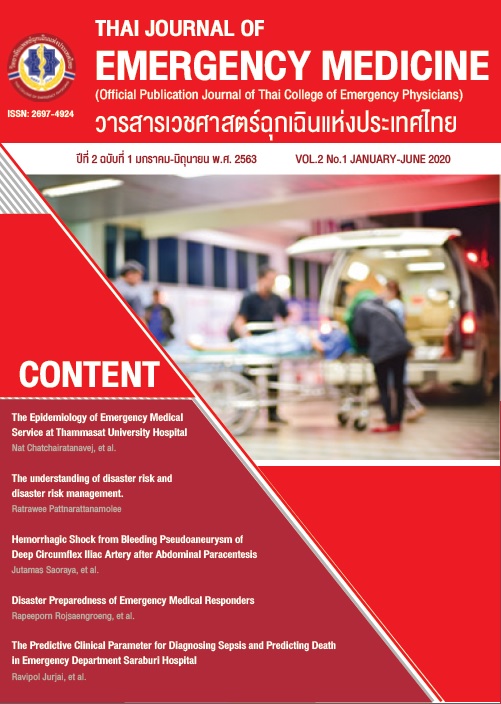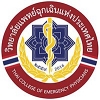The Epidemiology of Emergency Medical Service at Thammasat University Hospital
Keywords:
emergency patient, emergency department, emergency medical serviceAbstract
Introduction : The National Institute for Emergency Medicine by Ministry of Public Health of Thailand has developed Emergency Medical Service (EMS) for Thai people, who suffer from emergency illness, since 2002. The characteristics of emergency patients who used EMS might be helped emergency personal to develop the policy for emergency patients in the future.
Objective : This study aimed to determine the epidemiology of Emergency Medical Service used at Thammasat University Hospital.
Methods : This study was descriptive study of emergency patients who used emergency medical service and were transferred to Thammasat University Hospital between January and December 2017. All data from case record forms and emergency medical service charts were used to analyze.
Results : The total of 747 emergency patients, 73.09% were male, mean age was 34.90 years old (IQR; 20.00-45.00), the mean of response time was 6.30 minutes (IQR; 4.00-7.00), the distance from scene to Thammasat University Hospital was 3.9 kilometers (IQR; 2.00-4.00), most of patients transferred in afternoon shift (46.99%), 16.06% triaged at ED with critical level, 99.60% were traumatic patients, 71.22% were road traffic patients, 87.82%, 9.64%, and 2.54% were transferred by emergency medical responders, nurses, and physicians, respectively. 10.98% had pre-hospital interventions, 40.21% admitted in hospital, 59.33% were discharged at ED, and only 0.46% transferred to other hospitals.
Conclusion : Of 747 emergency patients, 73.09% were male, age 34.9 years old, 46.99% serviced on afternoon shift, 16.06% triaged at ED with critical level, 99.60% were traumatic patients, 87.82% transferred by emergency medical responders, 40.21% admitted in hospital and 59.33% discharged at ED. Therefore, the result of the study could be helped and informed the physician to improve the quality of emergency system in Thailand.
References
สถาบันการแพทย์ฉุกเฉินแห่งชาติ. คู่มือแนวทางการปฏิบัติตามหลักเกณฑ์ เกณฑ์ และวิธีปฏิบัติการคัดแยกผู้ป่วยฉุกเฉินและจัดลำดับการบริบาล ณ ห้องฉุกเฉินตามหลักเกณฑ์ที่ กพฉ. กำหนด. พิมพ์ครั้งที่ 3. นนทบุรี: สถาบันการแพทย์ฉุกเฉิน; 2558.
สถาบันการแพทย์ฉุกเฉินแห่งชาติ. รายงานประจำ ปี 2552 สถาบันการแพทย์ฉุกเฉินแห่งชาติ. กรุงเทพมหานคร: บจก.ปัญญมิตร การพิมพ์; 2553.
วิทยา ชาติบัญชาชัย, ไพศาล โชติกล่อม. ผู้ป่วยที่มาด้วยระบบการแพทย์ฉุกเฉิน (EMS Service) และผู้ป่วยที่มารับการรักษา ณ ห้องฉุกเฉิน (ER Visit) ของโรงพยาบาลในสังกัดสำนักงานปลัดกระทรวงสาธารณสุข ประจำปีงบประมาณ 2554. ขอนแก่น: โรงพยาบาลขอนแก่น; 2556.
สถาบันการแพทย์ฉุกเฉินแห่งชาติ. ช่องว่างการแพทย์ฉุกเฉิน : รายงานสถานการณ์ระบบการแพทย์ฉุกเฉิน ปี 2558. กรุงเทพมหานคร: บจก. ปัญญมิตร การพิมพ์; 2559.
อดิศักดิ์ นิธิเมธาโชค, จุฬณี สังเกตชน, ภัทร สุริจามร. อัตราการใช้บริการการแพทย์ฉุกเฉินในผู้ป่วย ฉุกเฉินเร่งด่วนและผู้ป่วยฉุกเฉินวิกฤตในเขตเมือง. วชิรเวชสารและวารสารเวชศาสตร์เขตเมือง 2561; 62:85-96.
กิตติพงศ์ พลเสน, ธีระ ศิริสมุด, พรทิพย์ วชิรดิลก. สถานการณ์การใช้บริการการแพทย์ฉุกเฉินของผู้ป่วยฉุกเฉินที่เข้ารับบริการแผนกอุบัติเหตุฉุกเฉินในประเทศไทย. วารสารสุขศึกษา 2561;41:51-63.
Shah MN, Bazarian JJ, Lerner EB, Fairbanks RJ, Barker WH, Auinger P, et al. The epidemiology of emergency medical services use by older adults: an analysis of the national hospital ambulatory medical care survey. Acad Emerg Med 2007;14:441-8.
Shah MN, Cushman JT, Davis CO, Bazarian JJ, Auinger P, Friedman B. The epidemiology of emergency medical services use by children: an analysis of the national hospital ambulatory medical care survey. Prehosp Emerg Care 2008;12:269-76.
Bart Jacobs CM, Oeun Sam, Sjoerd Postma. Ambulance services as part of the district health system in low-income countries: a feasibility study from Cambodia. Int J Health Plann Manage 2016;31(4):414-29.
Hunniya Waseem LC, Junaid Razzak, Rizwan Naseer. Epidemiology of major incidents: an EMS study from Pakistan. Int J Emerg Med 2011;4:48.
Daifallah M. Alrazeeni SAS, Abdulmajeed Mobrad, Mazen Al Ghamdi, Nabeel Abdulqader, Mohammed Al Gabgab, Majed Al Qahtani, et al. Epidemiology of non-transported emergency medical services calls in Saudi Arabia. Saudi Med J 2016;37(5):575-8.
สถาบันการแพทย์ฉุกเฉินแห่งชาติ. ผลการดำเนินงานของระบบบริการการแพทย์ฉุกเฉิน [อินเทอร์เน็ต]. 2561 [เข้าถึงเมื่อ 8 พ.ค. 2564]. เข้าถึงจาก: https://ws.niems.go.th/ITEMSDWH/
Amnuaypattanapon K, Udomsubpayakul U. Evaluation of related factors and the outcome in cardiac arrest resuscitation at Thammasat emergency department. J Med Assoc Thai 2010;93(Suppl.7):S26-34.
สถาบันการแพทย์ฉุกเฉินแห่งชาติ. ก้าวต่อไปของ UCEP. การประชุมวิชาการแพทย์ฉุกเฉิน ระดับชาติ ครั้งที่ 13. 29-31 พฤษภาคม 2562; กรุงเทพมหานคร. กรุงเทพมหานคร: สถาบันการแพทย์ฉุกเฉินแห่งชาติ; 2562.
สถาบันการแพทย์ฉุกเฉินแห่งชาติ. แผนหลักการแพทย์ฉุกเฉินแห่งชาติ ฉบับที่ 3.1 พ.ศ.2562-2564. พิมพ์ครั้งที่ 2. กรุงเทพมหานคร: บริษัท อัลทิเมท พริ้นติ้ง จำกัด; 2562.
American College of Surgeons-COT. Resources for optimal care of injured patient. Chicago: American College of Surgeons-COT;2014.
กฤษฎา สวมชัยภูมิ, วัลย์ลดา ฉันท์เรืองวณิชย์, อรพรรณ โตสิงห์, อภิชญา มั่นสมบูรณ์. ปัจจัยที่มีอิทธิพลต่อความถูกต้องในการคัดแยกผู้ป่วยฉุกเฉินโดยการใช้ด้ชนีความรุนแรงฉุกเฉิน. วารสารสภาการพยาบาล 2562;34:34-47.

Downloads
Published
How to Cite
Issue
Section
Categories
License
บทความที่ได้รับตีพิมพ์ในวารสารเวชศาสตร์ฉุกเฉินแห่งประเทศไทย ถือเป็นเป็นลิขสิทธิ์ของ วิทยาลัยแพทย์เวชศาสตร์ฉุกเฉินแห่งประเทศไทย
กรณีที่บทความได้รับการตีพิมพ์ในวารสารเวชศาสตร์ฉุกเฉินแห่งประเทศไทยแล้ว จะตีพิมพ์ในรูปแบบอิเล็กทรอนิกส์ ไม่มีสำเนาการพิมพ์ภายหลังหนังสือเผยแพร่เรียบร้อยแล้ว ผู้นิพนธ์ไม่สามารถนำบทความดังกล่าวไปนำเสนอหรือตีพิมพ์ในรูปแบบใดๆ ที่อื่นได้ หากมิได้รับคำอนุญาตจากวารสารเวชศาสตร์ฉุกเฉินแห่งประเทศไทย



